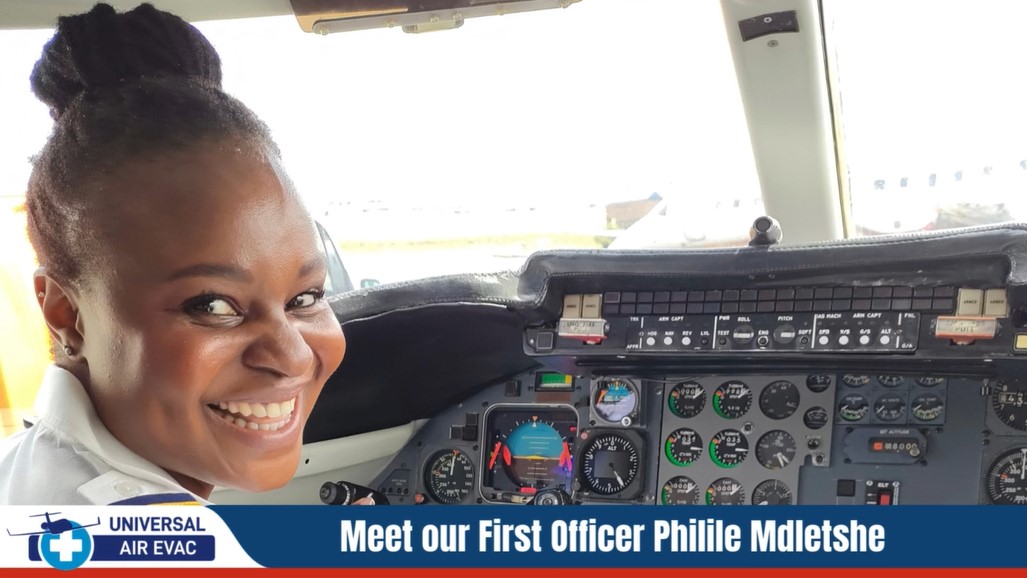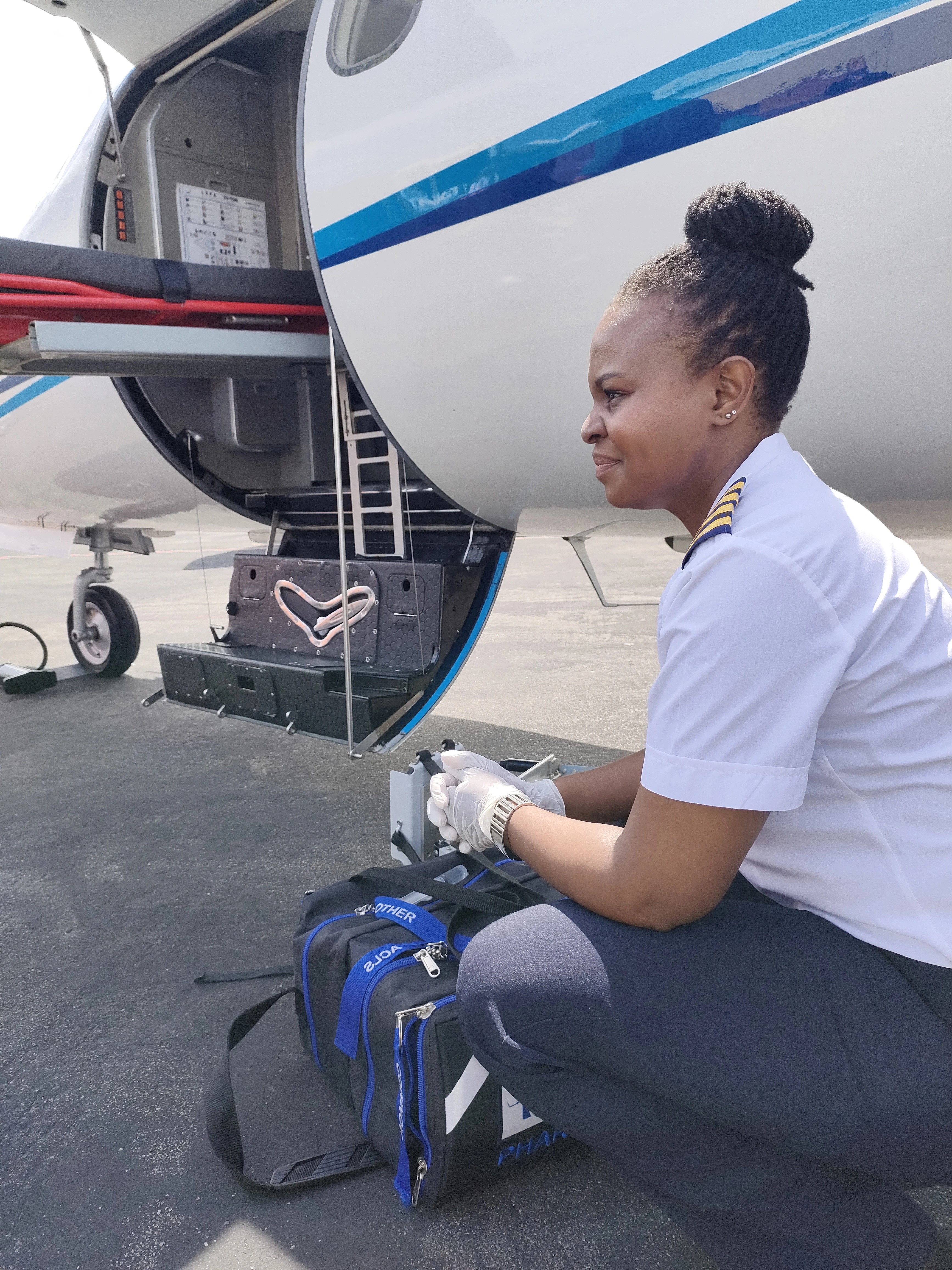In the Cockpit with First Officer Philile Mdletshe

At the age of 15, Philile was introduced to the prospect of becoming a pilot by SAA, which was creating awareness about the SAA Cadet Pilot Programme. Though her journey to the skies took a few detours, including earning a Bachelor of Commerce Degree, pursuing a career as an IT programmer, and overcoming some obstacles and setbacks, she never gave up on her dreams of an aviation career. Always maintaining the vision of becoming a pilot in the forefront of her mind, Philile pinned the SAA Cadet Pilot Programme pamphlet on the wall of her childhood bedroom.
Philile is rated on the Bombardier CRJ200, Beechcraft 1900, Embraer 120 and Learjet 35A.
Having flown with Universal Air Evac since September 2021, she has accumulated over 700+ hours on board the air ambulance. "I love flying the Learjet. It's a fast aircraft, and you must have your wits about you," says Philile. "The Learjet requires you to be hands-on, so you build your stick and rudder skills. You're also constantly challenged because you have to manage the aircraft's energy, given its speed."
Being a Pilot On Board a Life-saving Mission
Being a First Office on board the fixed-wing air ambulance is unpredictable because you don't know when, how long, or where your next mission might take you and, because you don't know where you might be flying to, you could go to a routine airport, like Lusaka or Mauritius, or to an airport you've never flown to before.
"No two days or missions are the same," says Philile. "My day-to-day is constantly changing. I could have a regional flight today, be in Europe tomorrow, and the day after that, I could be in the Indian Ocean Islands, Asia, Sri Lanka or the Atlantic Ocean islands."
Flying for Universal Air Evac, as a medevac pilot, provides you with the experience of flying outside your circadian rhythms, flying for long hours, and managing the flight duty period while ensuring you complete the mission within a certain time frame.
"And then there's the responsibility of having someone's life on board that relies on you to get them where they need to be for better healthcare." Philile emphasises, that once a patient is on board the flight, it's a race against time to ensure they reach their destination for the medical attention they require. "Their life depends on you and the rest of the team."
Staying Prepared for a Life-Saving Mission
One of the most crucial aspects of being a pilot on board a medevac flight is managing your rest. On the first call day, Philile anticipates being summoned to fly and leaves nothing to chance, ensuring she manages her call-out cycle by prioritising rest. "Out of 30 days, you're lucky if you fly 10 of those days, but those 10 days could involve long missions to Europe and back, which are tiring, or flying through the night."

As a pilot for a fixed-wing air ambulance, you don't get to fly every day to practice your skills, so being prepared is vital in terms of standard operating procedures, memory items and aircraft technicalities. "You have to be disciplined in taking the time to review the technical and standard operating procedures," says Philile. "I dedicate time to revisiting my previous flights, analysing what went wrong, and identifying areas for improvement for my next flight."
This, Philile emphasises, helps with mental preparation, ensuring continuous improvement and readiness for any situation.
"In this career, you need to be someone who loves spontaneity, is flexible, easily adaptable, and thrives under pressure."
Teamwork On Board a Life-Saving Mission
The duties and responsibilities of pilots and the medical crew are clearly defined. As pilots, you are responsible for the aircraft, ensuring its safe operation, and completing the mission within the stipulated duty period.
Medical personnel, on the other hand, are responsible for the patient's well-being.
However, pilots and medical personnel collaborate closely as a team toward the common goal of safely transporting the patient to their destination.
The success of these missions hinges on teamwork, not only between the captain and first officer but also with the medical crew.
"We all work together. We lift and load the patient as a team, and maintain constant communication," says Philile. "The medical crew communicates with us, requesting things like gentle accelerations or decelerations. Additionally, we receive some information about the patient's condition, allowing us as pilots to adjust our flight profile to ensure the utmost comfort for the patient."
For Future Pilots
If you're someone who doesn't enjoy being up at odd hours, being away from home for extended periods, or facing uncertainty about what each day might bring, then the life of a medevac pilot might not be the right fit for you.
"I believe it's essential to know yourself before entering any career path. Understand your strengths and weaknesses, and thoroughly research the career you're interested in," advises Philile.
She suggests asking yourself several questions:
- What does a pilot do?
- What training is required to become a pilot?
- How long does it take to reach that level?
- Why do I want to become a pilot?
Many individuals mistakenly assume that becoming a pilot involves attending flight school for 18 months and then immediately flying a Boeing 777. However, the reality is quite different.
"Becoming a pilot involves a significant amount of groundwork, preparation, and overcoming setbacks and challenges," concludes Philile. "What might initially seem like a 6-month journey could easily stretch to 12 or 18 months. The only thing that sustains you through the ups and downs is your 'why'."

